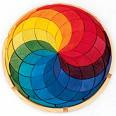 The striking deep blue of a quality sapphire is reminiscent of a cloudless night sky. Ancient civilizations believed that the world was set upon an enormous sapphire, which painted the sky blue with its reflection. This legend, as well as the belief that the Ten Commandments were inscribed upon tablets made of sapphire, gives September’s birthstone a royal place among gemstones. The sapphire was said to represent the purity of the soul.
The striking deep blue of a quality sapphire is reminiscent of a cloudless night sky. Ancient civilizations believed that the world was set upon an enormous sapphire, which painted the sky blue with its reflection. This legend, as well as the belief that the Ten Commandments were inscribed upon tablets made of sapphire, gives September’s birthstone a royal place among gemstones. The sapphire was said to represent the purity of the soul. Named after the Greek word "sapphirus", meaning blue, Sapphires have long been a favorite among priests and kings, who considered them symbolic of wisdom and purity.
In ancient times, Sapphires were thought to be protective against envy, and even against poisoning. A common belief was that a venomous snake placed in a Sapphire vessel would rapidly die! Ground to a powder, the blue stone was believed to cure colic, rheumatism and mental illness, and to strengthen eyesight.

Sapphire is the modern September birthstone as adopted by the American National Association of Jewelers in 1912 and the gem designated for the 5th, 23rd and 45th wedding anniversary; a star sapphire is typically given on the 65th wedding anniversary.
Sapphire is the non-red variety of corundum (the red variety of corundum is ruby). S sapphire is the second hardest natural mineral., only the diamond is harder.
Blue is by far the most popular color for sapphires, but they can be almost any color, including yellow, green, white, colorless, pink, orange, brown, and purple. Padparadscha is the name for a rare orange-pink variety of sapphire and has a higher value than blue sapphires.
Sapphires with inclusions of tiny, rutile needles exhibit an optical property called asterism. This is the star shaped effect seen in star sapphires and is usually only seen in cabochon cuts.
Star sapphires usually have six ray stars, but twelve ray stars are also known. Rarely, when sapphires are cut en cabochon, they can demonstrate a cat's eye effect. This effect displays a thin band of light down the center of the stone and is known as chatoyancy.
Star sapphires usually have six ray stars, but twelve ray stars are also known. Rarely, when sapphires are cut en cabochon, they can demonstrate a cat's eye effect. This effect displays a thin band of light down the center of the stone and is known as chatoyancy.
 Heating colorless and very pale blue sapphires to high temperatures is done to give them an intense blue color This treatment can also improve the clarity of the stones by removing tiny inclusions. A rare variety of sapphire, known as color changing sapphire, exhibits different colors in different light. A color change sapphire is blue in natural light, and violet in artificial light. A similar effect is also seen in alexandrite.
Heating colorless and very pale blue sapphires to high temperatures is done to give them an intense blue color This treatment can also improve the clarity of the stones by removing tiny inclusions. A rare variety of sapphire, known as color changing sapphire, exhibits different colors in different light. A color change sapphire is blue in natural light, and violet in artificial light. A similar effect is also seen in alexandrite. 




1 comment:
If you want to see some amazing colors, check out the all natural colors of mother nature at Wild Fish Gems. I stumbled upon your blog accidentally as I was researching sapphires but your love of color reminds me of how the colors on this website blow my mind everytime I visit it.
Post a Comment